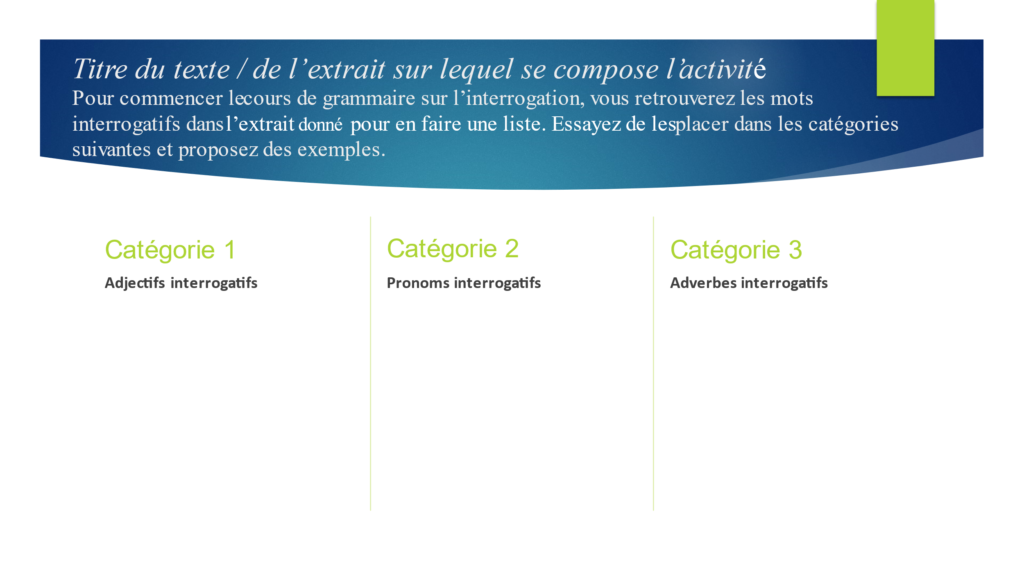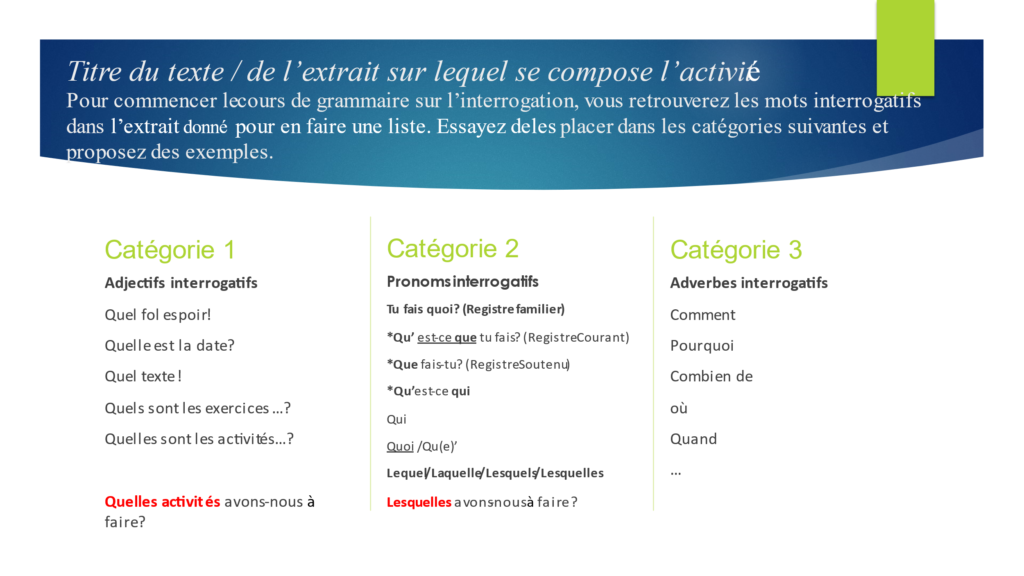Table of Contents
About the author
P. Julie Papaioannou
Associate Professor of Instruction in French
Modern Languages and Cultures, University of Rochester
About the Tool and Class
| Title | French Grammar Pre-Quizzes in VoiceThread |
| Tool | VoiceThread (http://voicethread.com) |
| Tool description | VoiceThread is a digital tool that allows synchronous use in the classroom and/or asynchronous student collaboration. VoiceThread is embedded in a learning management system (LMS) such as Blackboard and offers an interactive collaboration via video, audio, writing-editing, and an effective integration and accessibility of media. VoiceThread is supported by the University IT. |
| Class/ Target Level | Advanced French (fourth semester of French instruction). Adaptable to all levels of language instruction, from elementary to advanced. |
| Course Title | FREN 200 Advanced French |
| Background Information About the Class | This is a core course in the curriculum of the French program and is offered every semester. Course work focuses on intensive practice in reading, writing, and speaking French based on rigorous grammar review and close readings of short literary and cultural texts. The organization of the course and module activities are built on the concept of ‘leveling up’ grammar, listening, speaking, and writing skills. |
| Lesson Time | A 75-minute class that meets twice a week. The proposed lesson activity on VoiceThread is scheduled for approximately 15 minutes at the beginning of each module. No time restrictions were set for asynchronous use of this activity other than the activity should be prepared before the first class of each module. |
| Number of Students | The average number of students per class is 12. |
| Learning Objectives | The learning objectives for this activity follow the course objectives and outcomes: Students are expected to review and apply previous knowledge of grammar to examine, differentiate, categorize, and construct advanced and complex structures and expression in the target language. Students practice by constructing oral and written responses at the three different levels of registers in French. |
About the Tool and Class
Lesson Plan
Opening
VoiceThread is used to create pre-quizzes in each one of the six course modules to introduce the grammar concepts in the module while providing the opportunity to discuss a general overview, as well as key concepts of the lesson. This activity offers the option of synchronous and/or asynchronous use.
Body
In each course module, this VoiceThread pre-quiz activity is under the heading “Allons-y! C’est ici que ça commence!” (“Here we go! This is where to begin!”). An image, drawing, or cartoon may accompany the heading to highlight the activity instructions and add a pleasant and inviting tone to this grammar pre-quiz. The layout and presentation of this VoiceThread activity (heading, image, instructions, etc.) are consistently the same in every module and are easily recognizable within the module.
This VoiceThread activity functions as a scaffold at multiple levels:
• As a cognitive scaffold, it orients students procedurally. Students know where and how to begin their lesson in every module of the course.
• As a metacognitive scaffold, it presents the foundational knowledge students are expected to apply in French grammar to perform their self-evaluation. Students are also directed to review foundational rules before the class begins to practice and build an understanding of more complex or idiomatic structures within the module.
• As a conceptual and strategic scaffold, this activity opens questions, invites participants to exchange their evaluation of the topic, observe and create examples by presenting alternative solutions and applications.
For example, in the first module of the course that focuses on the structure and function of Interrogative sentences, students work on an excerpt of a literary work and after they read, and discuss context, they are presented with instructions to:
• focus on registers of language in the text
• retrieve questions and the way they function in the text
• focus on the use and function of interrogative words
• classify interrogative words per given category (slide 1) and justify categorization by use of example either retrieved from text or formulated by students themselves (slide 2 depicts activity in progress)


Closing
VoiceThread as a pre-quiz activity invites student collaboration in groups and the opportunity for class interaction to support an active contextual review, learning, and practice of French grammar. The synchronous use of this group activity aims to highlight major rules and points and elicits a stronger collaborative reaction on grammar topics that are often considered as dull material that take away the excitement of mastering communication in French.
Findings/assessment
This activity affords a preliminary non-graded assessment of student background knowledge so that the instructor can facilitate the pace of lessons and practice within the module by tailoring activities to target student needs in their review and application of French grammar in contextual practice (such as writing short critical responses and essays on literary readings, as well as practicing presentational skills and oral communication).
Accommodation
Accommodation/differentiation
VoiceThread easily accommodates participants who need or place a request for accommodations. This tool offers versatile options for presenting and constructing or responding to activities orally/aurally and in writing, and with audiovisual support. The tool is linked in Blackboard and is easily accessible.
However, if barriers exist for some participants such as
• opting out of using the technology; for example, the audiovisual aspect of the tool may create an intimidating environment to any participant practicing another modern language
• an issue of connectivity
the pre-quiz activities may be supported outside of VoiceThread in different and more conventional ways. The pre-quiz example used here may be easily supported by projecting or copying the PowerPoint slide and do the group work solely in the classroom without responding, posting, or otherwise collaborating synchronously and/or asynchronously in VoiceThread.
Reflection
Reflection from instructor
A VoiceThread pre-quiz enhances collaboration in the classroom (for example, every student or student group can respond in writing using VoiceThread during the allotted time) to perform an assessment on strengths and weaknesses of the class while, by breaking away from the traditional quiz or test format, it supports an active contextual review of grammar rules. This tool advances asynchronous collaboration outside of class by responding, commenting, organizing, posting work, and reviewing each other’s responses before class meets. In asynchronous interaction, the instructor reviews, responds, and posts materials to invite discussion in the classroom.
When grammar VoiceThread pre-quizzes were used asynchronously, some students formed the impression that this activity oriented them to a flipped class model. Although this activity presents a review of prerequisite knowledge as a starting point, a small number of students found it challenging because it presented grammar questions on which students were invited to perform and undertake a self-assessment. For others, it was additional homework that they tackled successfully.
To enhance self-evaluation with this non-graded pre-quiz, creating a rubric for students to mark their successful or not so successful answers enables and guides them during their practice within the module.
Preparation time/materials
Depending on media use and selection of activities to include, preparation time varies; an average time is between 30-45 minutes.
Benefits and challenges of the tool
The benefits of using VoiceThread as a pre-quiz activity:
• Individual feedback by the instructor and participants is enabled, but it is not private
• The tool supports different options for participation and is adaptable to accommodations.
• It can be used synchronously and asynchronously but affords different capabilities depending on use
In-class experience
Students were in favor of this activity when done synchronously in class with the instructor participating and facilitating group work. When asynchronous, this activity required that students do more preparation ahead of time and was more challenging for some students in terms of their level of experience with asynchronous learning and time commitment.
Ease of use/Ranking
This activity is easily modified to accommodate participants from beginner to advanced levels.
Reference
Stavredes, Tina. Effective Online Teaching: Foundations and Strategies for Student Success, John Wiley & Sons, Inc., 2011.
This work is licensed under a Creative Commons Attribution-NonCommercial 4.0 International License.